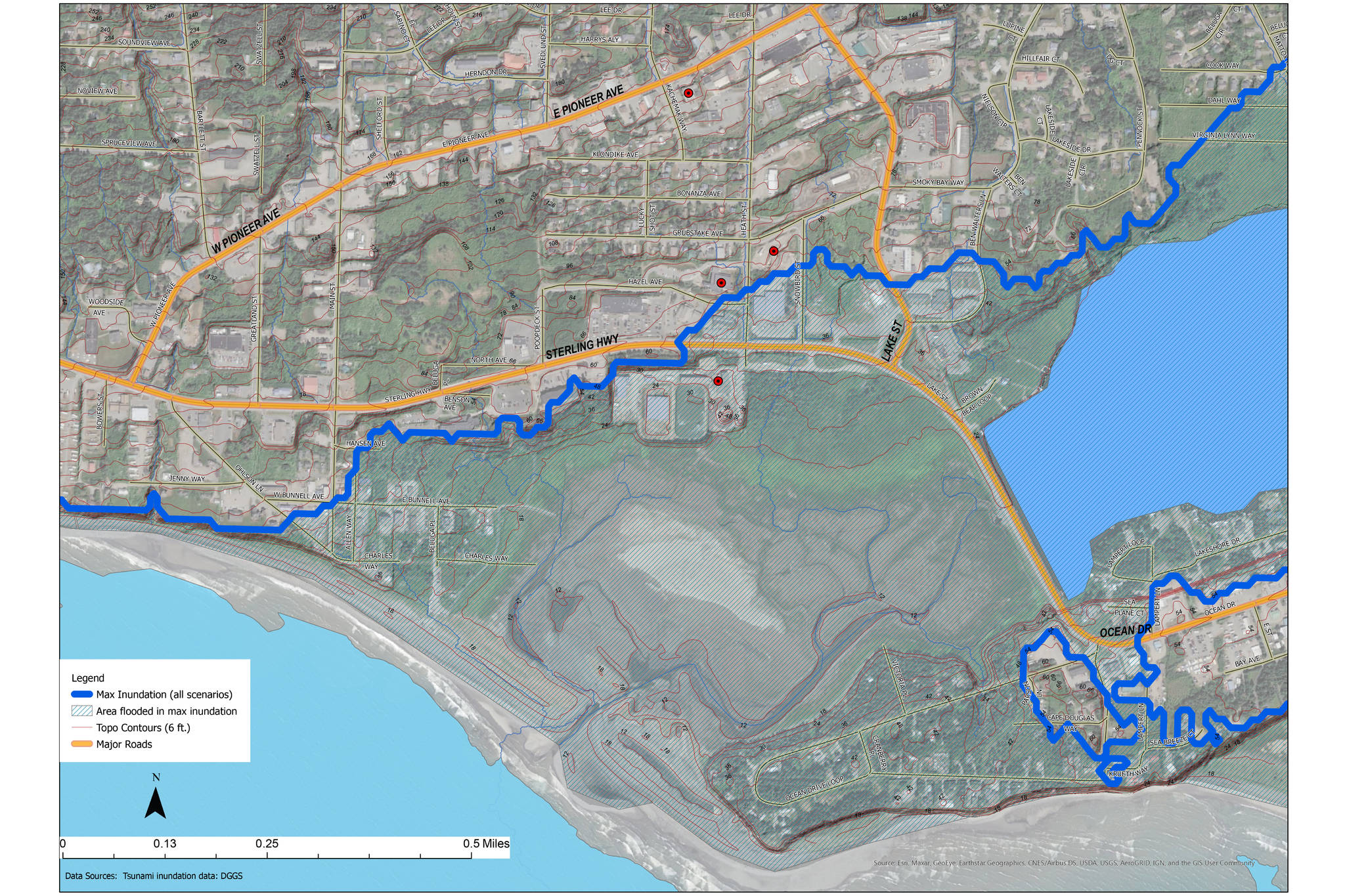The City of Homer Public Works Campus Task Force presented its final recommendations at the Aug. 23 Homer City Council meeting and suggested the city take a phased approach to address short-term safety concerns and long-term space needs regarding the location and obsolescence of the Public Works campus.
The campus on the south side of the Sterling Highway near Heath Street lies below the 50-foot tsunami inundation zone.
The task force was comprised of Public Works Director Jan Keiser, Deputy City Planner Julie Engebretsen, two city council members Donna Aderhold and Caroline Venuti, three Homer residents Jacob Argueta, Charles Barnwell and Larry Slone, along with staff liaison Renee Krause for support.
The group was responsible for evaluating the risks of personal injury, property damage and loss of life in the event a tsunami floods the public works campus; developing strategies for mitigating identified risks, and recommending a plan of action after assessing their findings. The task force was created in response to the information derived from the Alaska Division of Geological & Geophysical Survey’s 2019 Tsunami Inundation Report, which determined the Homer Public Works Campus to be at high risk of infrastructure loss if a tsunami were to hit Homer.
“We spent a lot of time looking at the tsunami report to figure out how much risk there was and how much that risk would apply to our decision. We talked with the experts on it, and in the end, there was risk to Public Works,” Engebretsen said in a phone interview on Tuesday. “If you were building a new critical facility today, you likely would not put it in the tsunami zone. Public Works is a critical facility.”
The Public Works Department is responsible for maintaining the city’s roads, drainage, water distribution, wastewater collection, buildings and facilities, and motor vehicles.
The Homer blue line, or inundation zone, is 50 feet above sea level. The campus is located at 3575 Heath Street along Beluga Slough, and is at 35 feet elevation and at risk for inundation.
The 2019 report was created by modeling the worst case scenarios of inundation from tsunami waves created by earthquakes and submarine landslides.
The current evacuation process for Public Works requires personnel to immediately begin moving heavy machinery and mobile equipment to higher ground near the library, which takes roughly 45 minutes and does not account for many materials and supplies needed to make repairs to the city after a tsunami.
During the Aug. 23 meeting, Engebretsen and Barnwell, representing the task force, recommended the city take a phased approach to moving the necessary equipment and buildings to a new location on Lake Street above the inundation zone. The city would need to purchase the recommended land for sale on Lake Street to build a mechanic shop, motor pool for heavy equipment, equipment barns and a fuel depot. Additionally, the transfer would free up space at the campus to allow building maintenance and parks to move in from the HERC buildings.
Light equipment, offices, the sewer plant and sand pile would remain at the current Public Works campus.
“Our conclusions are we can’t really move all of Public Works. It’s too expensive and it’s not necessary,” Engebretsen said during the meeting. “… But we can make long-term plans for future facilities and near-term plans for needed mechanic and motor pool spaces.”
The group also determined the current mechanic shops are too small to accommodate the city’s large equipment and are out of space to house any new machinery. While the Public Works campus move would keep it safe from potential tsunamis, it would also allow for long-term growth, Engebretsen said.
“We looked at it from a perspective that maybe you wouldn’t move it just because you might have a risk of a tsunami, but we should definitely be looking at the long-term usage of that facility and what Public Work’s needs are,” Engebretsen said on the phone interview. “… It would behoove the city to think about in a 30-year time frame, 50-year time frame, how are we going to be providing services to the public and what investment do we need to make today to be sure we can continue to offer our high level of service?”
“The Public Works campus is suffering from obsolescence due to growth and technological changes, triggering the need for facilities planning and subsequent implementation,” reads the final report.
According to Engebretsen, it is up to the city council for what happens next. The council did not ask the task force representative any questions during the meeting, but she is hopeful the council members will study the report and move forward with their recommendations quickly.
For more information about the Public Works Campus Task Force, visit www.cityofhomer-ak.gov/publicworks/public-works-campus-task-force.
Reach Sarah Knapp at sarah.knapp@homernews.com. Charles Barnwell is the brother-in-law of Homer News editor and reporter Michael Armstrong.


